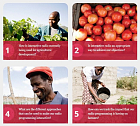Radio, TV, Internet and other mass media have the great advantage of being able to reach a large number of people while transferring not only facts but also emotions. The following resources focus on the use of radio programs. Let us know if you think that an important resource is missing.
Mass Media: Reaching Audiences Far and Wide
2017, High Impact Practices
Mass media programming in reproductive health can influence individual behaviors by providing accurate information, building self-efficacy, and promoting attitudes and social norms that support healthy reproductive behaviors. This brief describes the evidence on and experience with mass media programming in family planning.
A Guide to Adapting, Developing and Producing Effective Radio Spots
2005, CHANGE Project
This well-written publication provides guidance on adapting, creating, testing, producing, placing and evaluating radio spots. Although its main focus is on malaria prevention and treatment, the promoted methods can easily be applied to many other topics.
Behavior Change Through Mass Communication
FHI
This handbook provides useful guidance on the use of radio, televison and printed media as a part of your social and behaviour change efforts. While its main focus is on HIV/AIDS prevention, the gudiance is very useful also for inteventions focusing on other topics.
Interactive Radio for Agricultural Development Projects: A Toolkit for Practitioners
2012, FHI 360
This on-line toolkit was designed to provide practitioners with a foundational understanding of what is needed to create compelling radio programming, as well as how to develop a more systematic approach to using interactive radio as one medium through which they share information with farmers.
Digital and Social Media for Social and Behaviour Change Communication
2019, iMedia Associates
This paper explores the ways in which digital and social media channels can be used successfully, appropriately, and responsibly to drive behaviour change in young men and women from lower socioeconomic groups.



